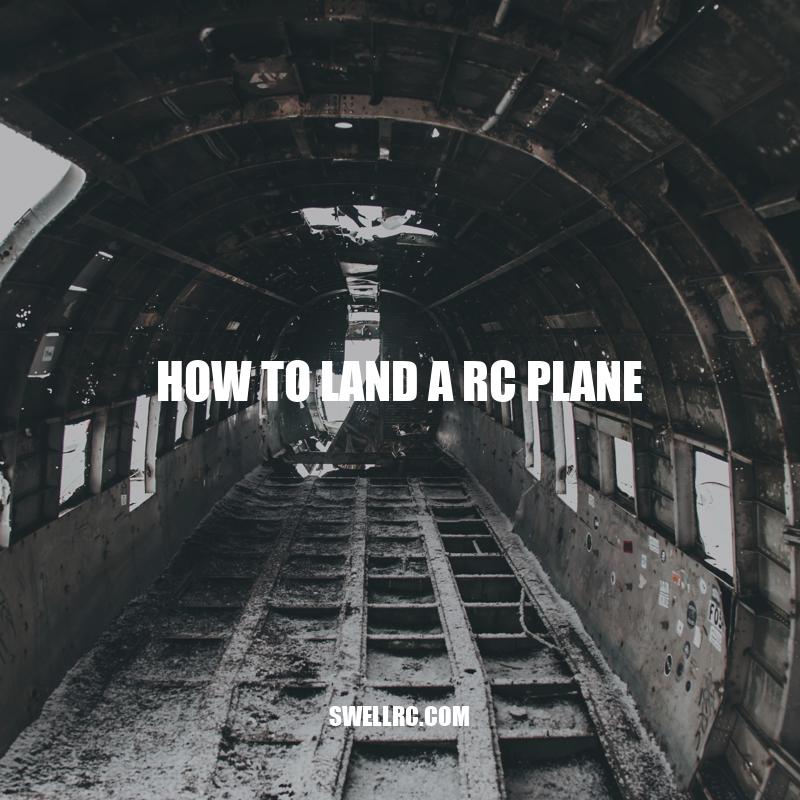Tips for Landing a RC Plane Safely
Landing a remote-controlled (RC) plane is a skill that every hobbyist needs to master to ensure a safe and successful flying experience. While it can be intimidating for beginners, with the ability to maneuver the plane in real-time, understanding the basics of RC planes along with some tried and tested techniques, any hobbyist, regardless of their experience, can achieve this feat. From choosing the right landing spot to approaching the landing with care to timing the touchdown, there are many factors that come into play. Additionally, there are challenges such as dealing with wind, terrain, and other obstacles that make the landing process challenging. In this article, we will take a look at some of the most essential tips and techniques to help you land your RC plane with confidence, including basic understandings of an RC plane, finding the right landing spot, approaching the landing, timing the touchdown, dealing with wind and other challenges, and finally, maintaining your RC plane after every flight.
Understanding the Basics of Landing a RC Plane
Before you attempt to land your RC plane, you need to understand the basics of how it operates. Here are a few things you need to know:
- Familiarize yourself with the different parts of the plane, including the wings, control surfaces, and landing gear
- Practice flying the plane in a safe and open area to become familiar with how it responds to different commands and wind conditions
- Understand the different types of landings such as a full stall-landing, touch-and-go landing, and wheels to the ground landing
Online resources such as RC Universe, RC Groups, and RC Planet have a wealth of information on how to effectively fly and land an RC plane. Additionally, there are products such as RC flight simulators that can help you hone your skills as a pilot without risking damage to your plane. By understanding the basics of RC planes and how to fly them, you can increase your chances of successfully landing your aircraft every time.
How do you land an RC plane?
Landing an RC plane is a crucial part of the flying experience. Here are some steps to help you land your RC plane smoothly:
- Reduce the throttle and descend towards the runway at a shallow angle.
- Trim the elevator to maintain a steady descent.
- Pull the throttle to idle as you approach the runway.
- Gently flare the plane by pulling back on the elevator to level it out.
- Let the plane glide in until it touches down.
Remember to practice and take it slow when learning to land your RC plane.
If you’re looking for more tips and tutorials on flying RC planes, check out websites like modelairplanenews.com or hobbyking.com for products and resources.
Choosing the Right Landing Spot
The location you choose for landing your RC plane could make or break your entire flight. Here are a few things to keep in mind when deciding on the appropriate landing spot:
Factors to consider when selecting a landing spot
| Factor | Description |
|---|---|
| Flatness | The surface of your landing spot should be flat or as flat as possible |
| Obstacles | Ensure that the area around your landing spot is obstacle-free to prevent crashes |
| Size | Choose a landing spot that is big enough to give your RC plane sufficient space to maneuver. |
| Wind conditions | Make sure that the wind conditions in the area are ideal for landing your RC plane |
RC flying clubs often have designated landing fields that are well suited for RC plane landings. Google Maps satellite view could also help you find suitable landing spots in your area.
It is important to further note that it takes practice, patience, and focus to land a remote-controlled airplane safely. Each airplane model possesses unique characteristics, and perfecting your skill on one plane will not always transfer to the next. By following the tips mentioned above, however, you can increase your chances of pulling off a smooth and safe landing every time.
What is the best way to land a plane?
- Reduce speed to the recommended approach speed for your aircraft
- Choose an appropriate point to begin your descent towards the runway
- Line up with the runway centerline and establish proper glidepath and descent rate
- Stay coordinated with rudder and aileron inputs
- Level off just above the runway and reduce to minimum flying speed
- Flare the aircraft just before touchdown to reduce descent rate and land softly
For more in-depth information on landing techniques and procedures, refer to resources such as the Federal Aviation Administration’s pilot handbooks or online aviation forums.
Approaching the Landing
Once you have selected the perfect spot to land, it is time to start preparing for the actual landing. Here are a few things to keep in mind when approaching the landing:
Steps to follow when approaching the landing
- Gradually reduce the throttle to decrease the speed of the plane
- Lower the nose of the plane to begin the descent
- Use the rudder to center the plane with the landing spot when performing a final approach
- Apply up elevator as you near the ground to cushion the landing
- Aim to touch the wheels or skids down level and straight with the ground
It is essential to keep an eye on the plane at all times, adjusting your approach angle as needed to ensure a safe and controlled landing. Don’t be afraid to abort the landing at the last minute, especially if something doesn’t feel right.
Remember, every RC airplane model is different, and you will need to experiment a bit to find the perfect approach speed for landing. With consistent practice and focused attention, you will soon be able to enjoy landing your RC plane like a pro.
How do you slow down a RC plane for landing?
There are several ways to slow down a RC plane for landing:
- Reduce throttle gradually
- Apply flaps or air brakes for added drag
- Make a shallow descent rather than a steep one
Properly slowing down a RC plane is crucial for a safe and successful landing. For more tips and tricks on RC plane flying, check out websites such as rcgroups.com or products such as the RC Plane Landing Gear.
Dealing with Wind and Other Challenges
Landing an RC plane can be challenging on its own. Dealing with wind and other obstacles can add to the complexity. Here are some tips to help you deal with these difficulties:
Tips for Dealing with Wind and Other Challenges
- Adjust your approach speed and timing to compensate for wind conditions
- Be prepared to abort the landing if wind conditions make it unsafe
- Practice landing in different wind conditions to improve your skills and comfort level
- Monitor your battery life and avoid flying if your battery is running low
- Follow all safety guidelines and maintain a safe distance from obstacles and people
Remember to always prioritize safety when flying and landing your RC plane. It is better to abort the landing than to risk damaging your plane or causing harm to people or property.
There are a lot of resources online to help you learn more about flying and landing RC planes. YouTube and hobbyist forums are the perfect places to find instructional videos and tips from experienced pilots. You can also find quality RC planes and parts online from retailers such as Amazon, Horizon Hobby, or Tower Hobbies.
Are RC planes hard to land?
Here are some key points to consider when landing an RC plane:
- RC planes can be tricky to land, especially for beginners who are still learning how to fly.
- The size and weight of the plane can also affect its landing, as well as factors such as wind and runway conditions.
- It’s important to practice landing your RC plane in a safe and controlled environment, such as a local flying club or designated RC flying field.
- There are resources available, such as online forums and instructional videos, that can help you improve your skills and technique when it comes to landing your RC plane.
For those interested in purchasing RC planes or accessories, websites such as Horizon Hobby offer a wide selection of models and products for hobbyists of all skill levels.
Maintaining Your RC Plane
Consistent maintenance is essential in order to keep your RC plane running smoothly and staying in good condition. Here are some tips to help you keep your plane in top shape:
- Check your aircraft thoroughly for any signs of damage after each flight
- Perform regular maintenance on your RC plane, including cleaning and tightening any loose screws
- Replace any parts that are worn or broken
- Store your RC plane in a dry, cool place to prevent rust and degradation
- Follow the manufacturer’s recommendations for maintenance and upkeep
Keeping your RC plane well-maintained not only extends its lifespan, but also ensures that it is safe to fly for you and those around you.
In addition to maintaining your plane, it is also important to have the right tools and accessories. You can find quality parts and accessories for your RC plane at online retailers such as Hobbyking and AMain Hobbies. You may also want to check out forums and online communities for tips on maintenance and upgrades.
What is the proper maintenance of an aircraft?
Proper maintenance of an aircraft is crucial for its safe operation. Here are some key aspects of aircraft maintenance:
- Regular inspections and checks of all systems, including engines, avionics, airframe, and fuel systems.
- Replacement and repair of worn or damaged parts according to manufacturer specifications.
- Strict adherence to maintenance schedules and procedures outlined in the aircraft’s maintenance manual.
- Aircraft should be kept clean and protected from the elements to avoid corrosion and other damage.
- Regularly reviewing and updating flight logs and maintenance records to ensure compliance with regulations and manufacturer recommendations.
For more information on aircraft maintenance, you can visit the Federal Aviation Administration’s website or look into products such as aircraft maintenance software, which can streamline the maintenance process for aircraft owners and operators.
Conclusion
Landing a remote-controlled plane can seem daunting at first, but with practice and patience, it is a skill that can be mastered. Understanding the basics of how your RC plane works, choosing the right landing spot, timing the touchdown, and being prepared for wind and other challenges are key to successful landings. Additionally, consistent maintenance is crucial in keeping your plane running smoothly and prolonging its lifespan.
Remember to always prioritize safety and follow best practices when operating your RC plane. Learning to land your plane takes time and practice, so don’t be discouraged if you encounter some setbacks along the way. Use the resources available to you, such as online forums and communities, to connect with fellow hobbyists and learn from their experiences.
In conclusion, landing a RC plane requires a combination of knowledge, practice, and patience. By following the tips and techniques outlined in this article and regularly maintaining your plane, you can enjoy the thrill of flying and landing your RC plane with confidence and skill.



